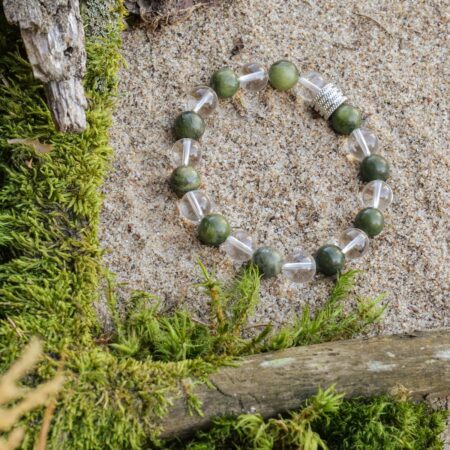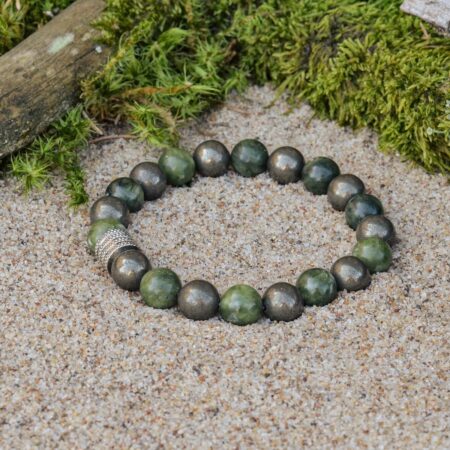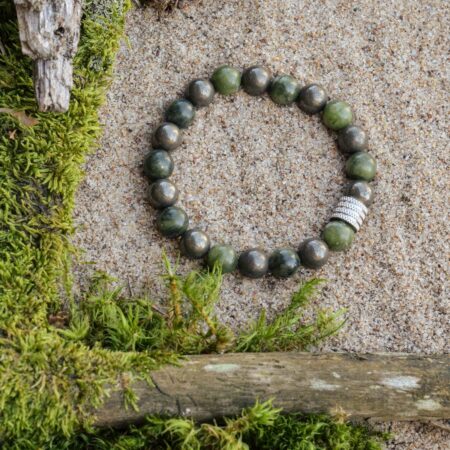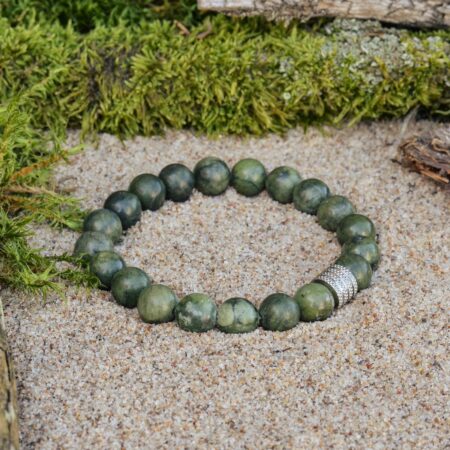
Nephrite (Jade)
3 results
- Tourmaline quartz
- Cat eye
- Apatite
- Fluorite
- Kyanite
- Selenite
- Smoky quartz
- Howlite
- Anyolite (Zoisite)
- Black Tourmaline (Sherlock)
- Malachite
- Rhyolite
- Beryl
- Rhodochrosite
- Iolite
- Keychains
- Crystal Pendants
- Bracelets by zodiac sign
- Bracelets for couples
- Chakra bracelets
- Earrings
- Pearl
- Mumz
- Uncategorized
- Men Bracelets
- Luck Bracelets
- Rhodonite
- Red Jasper
- Unakite
- Nephrite (Jade)
- Black Obsidian
- Carnelian
- Lapis Lazuli
- Tiger Eye
- Aquamarine
- Hematite
- Feldspar
- Agate
- Labradorite
- Lava Stone
- Citrine
- Garnet
- Clear Quartz
- Amethyst
- Calcite
- Snowflake Obsidian
- Sodalite
- Pyrite
- Aventurine
- Angelite
- Amazonite
- Heliotrope (Bloodstone)
-
Nephrite (Jade) and Clear Quartz Bracelet 33.99 $
✅ 30-day unconditional money-back guarantee.
✅ 6 month guarantee.
✅ Stones are CERTIFIED by the Museum of Geomology.
✅ Perfect as a meaningful, interesting and original gift.
✅ See for yourself the healing properties. -
Nephrite (Jade) and Pyrite Bracelet 33.99 $
✅ 30-day unconditional money-back guarantee.
✅ 6 month guarantee.
✅ Stones are CERTIFIED by the Museum of Geomology.
✅ Perfect as a meaningful, interesting and original gift.
✅ See for yourself the healing properties. -
Nephrite (Jade) Bracelet 33.99 $
🟢 A Nephrite bracelet is known for its vibrant green colour, often described as “emerald green”. The rich and gorgeous shade adds a touch of elegance to any outfit.
🟢 Its smooth surface makes it comfortable to wear on the wrist. The elegant texture of the bracelet enhances its overall appeal.
🟢 Nephrite is believed to have protective and healing properties. It is said to promote harmony, balance and good luck, making it a popular choice for those seeking positive energy and prosperity.
🟢 A Nephrite bracelet is durable and long-lasting. It resists scratches and wear and tear, keeping its beauty for a long time.
Nephrite (Jade)
Nephrite is a type of mineral known for its toughness, durability, and pleasing green color. It is one of two minerals that are commonly referred to as jade, the other being jadeite. Nephrite is composed of calcium, magnesium, and iron, and its chemical formula is Ca2(Mg,Fe)5Si8O22(OH)2.
Nephrite is found in many parts of the world, including China, New Zealand, Russia, Canada, and the United States. It has been used for thousands of years in various cultures as a material for carvings, jewelry, and other decorative objects.
In traditional Chinese culture, nephrite was believed to have healing properties and was used for a variety of medicinal purposes. In Maori culture in New Zealand, it was considered a sacred stone and was used in carvings and for ceremonial objects.
Today, nephrite is still used in jewelry and carvings, and collectors and enthusiasts highly value it. Its toughness and durability make it an ideal material for carving intricate designs and sculptures, and its unique color and pattern variations make each piece of nephrite unique.
History And Origin of Nephrite
The history and origin of nephrite jade can be traced back thousands of years. It is believed that nephrite was first discovered and used in China during the Neolithic period, around 5000 BCE. Chinese culture has a long and rich tradition of using nephrite for carving, decorative objects, and ceremonial purposes.
Nephrite was also highly valued by the Maori people of New Zealand, who called it “pounamu.” It was considered a sacred stone and was used in carvings and for ceremonial objects. Nephrite was also traded extensively throughout the Pacific region, with the Maori trading it with other indigenous cultures.
In addition to China and New Zealand, nephrite has been found in other parts of the world, including Russia, Canada, and the United States. In the Americas, nephrite was used by indigenous peoples for tools and weapons, such as knives and axes.
Throughout history, nephrite has been prized for its toughness, durability, and pleasing green color. It was believed to have healing properties and was used for various medicinal purposes. Today, collectors and enthusiasts still highly valued nephrite for its unique beauty and cultural significance.
Nephrite jade Physical properties
Nephrite is a type of mineral that is known for its toughness, durability, and pleasing green color. Here are some of its physical properties:
Hardness: Nephrite has a hardness of 6 to 6.5 on the Mohs scale, which means it is relatively hard and resistant to scratches.
Toughness: Nephrite is one of the toughest minerals known, which means it is resistant to breaking, chipping, and cracking.
Density: The density of nephrite varies depending on the composition, but it typically has a density between 2.9 and 3.3 g/cm³.
Color: Nephrite is typically green, but it can also be white, yellow, brown, or black. The color is influenced by the presence of iron and other trace elements.
Lustre: Nephrite has a waxy or oily lustre, which gives it a smooth and polished appearance.
Translucency: Nephrite can be translucent or opaque, depending on the quality and composition of the mineral.
Cleavage: Nephrite has a poor cleavage, which means it does not break along distinct planes.
What Is The Chakra For Nephrite Jade?
In crystal healing and chakra therapy, nephrite jade is believed to be associated with the heart chakra, which is located in the center of the chest. The heart chakra is associated with love, compassion, and emotional balance, and is believed to be the center of our emotional and spiritual well-being.
Nephrite jade is believed to have a soothing and healing effect on the heart chakra, promoting feelings of love, harmony, and balance. It is also believed to help release negative emotions and promote forgiveness and understanding.
In addition to the heart chakra, nephrite jade is associated with the root chakra at the spine’s base. The root chakra is associated with grounding, stability, and physical energy and is believed to be the foundation for all other chakras.
Overall, nephrite jade is considered a powerful stone for promoting emotional and spiritual balance and is often used in meditation, energy healing, and chakra therapy.
Beautiful Variations: The Different Types Of Nephrite
Nephrite jade is a beautiful mineral highly valued for its unique color and pattern variations. Here are some of the different types of nephrite:
Hetian Jade: Hetian jade, also known as “mutton fat jade,” is a type of nephrite that is found in the Hetian region of China. It is known for its white, creamy color and translucent quality.
Canadian Jade: Canadian jade, also known as “British Columbia jade,” is a type of nephrite that is found in British Columbia, Canada. It is known for its deep green color and high quality.
Wyoming Jade: Wyoming jade is a type of nephrite found in Wyoming, USA. It is known for its bright green color and high quality.
Siberian Jade: Siberian jade is a type of nephrite found in Siberia, Russia. It is known for its deep green color and unique pattern variations.
New Zealand Jade: New Zealand jade, also known as “pounamu,” is a type of nephrite found in New Zealand. It is known for its dark green color and is considered a sacred stone by the Maori people.
Lavender Jade: Lavender jade is a type of nephrite known for its pale color. It is relatively rare and highly prized by collectors.
Black Jade: Black jade is a type of nephrite known for its deep black color. It is relatively rare and highly prized by collectors.
These are just some of the many types of nephrite jade, each with its own unique beauty and cultural significance. The color and pattern variations make each piece of nephrite jade unique and highly valued.
Spiritual Properties of Nephrite Jade
Nephrite jade is believed to have a range of spiritual and metaphysical properties. Here are some of the most commonly attributed spiritual properties of nephrite jade:
Protection: Nephrite jade is believed to have a protective energy that shields the wearer from negative energies and entities.
Harmony: Nephrite jade promotes harmony and balance in all areas of life, helping to create a sense of peace and tranquility.
Abundance: Nephrite jade is believed to attract abundance and prosperity into one’s life, helping to bring about financial success and material wealth.
Healing: Nephrite jade is said to have a healing energy that can help to promote physical, emotional, and spiritual well-being. It is often used in crystal healing to treat various ailments and imbalances.
Love: Nephrite jade is believed to promote love and compassion, helping to open the heart chakra and connect the wearer with the universal energy of love.
Clarity: Nephrite jade promotes mental clarity and focus, helping to clear the mind of distractions and promote greater concentration and productivity.
Nephrite jade is considered a powerful stone for promoting spiritual growth and transformation. It is often used in meditation, energy healing, and spiritual practices to help bring about positive changes in one’s life.
What Is Nephrite Jade Used For
Nephrite jade has been highly valued and used for a variety of purposes throughout history, including:
Jewelry: Nephrite jade is a popular material for making jewelry, such as necklaces, bracelets, and earrings, due to its unique color and pattern variations. It has been used for this purpose for thousands of years and is highly prized for its beauty.
Carvings: Nephrite jade is also commonly used for carving figurines, sculptures, and other decorative objects. It is a relatively hard stone and can be carved into intricate shapes and designs with great detail.
Tools: In some cultures, nephrite jade made tools such as knives, axes, and other cutting instruments. Its toughness and durability made it ideal for use in these types of applications.
Spiritual and Cultural Practices: Nephrite jade has also been used in spiritual and cultural practices throughout history. It is believed to have protective and healing properties and has been used in rituals and ceremonies to promote well-being and spiritual growth.
Decorative Objects: Nephrite jade has been used to create various decorative objects, including vases, bowls, and other home decor items. Its unique beauty and durability make it a popular choice for creating functional and decorative objects alike.
Overall, nephrite jade is a highly versatile material that has been used for a wide range of purposes throughout history. Its unique beauty and properties continue to make it a popular choice today for jewelry, decorative objects, and spiritual practices.
Is Nephrite Jade Valuable?
Yes, nephrite jade is considered a valuable gemstone due to its unique beauty and cultural significance. The value of nephrite jade can vary depending on several factors, including its color, quality, size, and the region where it was sourced. Hetian jade, for example, is considered to be some of the highest quality nephrite jade and is highly valued by collectors.
In addition to its physical properties, the cultural and historical significance of nephrite jade also contributes to its value. Nephrite jade has been highly prized and used for decorative and spiritual purposes for thousands of years in cultures worldwide, including in China, New Zealand, and Central America.
Overall, the value of nephrite jade is determined by a variety of factors, including its rarity, quality, and cultural significance, and it can range from a few dollars for a small piece to thousands or even millions of dollars for large, high-quality pieces with a rich history and provenance.
What is the Price of Nephrite Jade?
The price of nephrite jade can vary greatly depending on several factors such as color, quality, size, and origin. Generally, high-quality nephrite jade can command a high price in the market.
In general, smaller and lower-quality nephrite jade pieces can cost a few dollars, while larger and higher-quality pieces can cost thousands of dollars or more. For example, a small nephrite jade pendant may cost around $20, while a larger, higher-quality nephrite jade sculpture can cost tens of thousands or more.
Hetian jade, a high-quality nephrite jade from China, is considered one of the most valuable and can fetch high prices in the market. Prices for Hetian jade can range from a few hundred to tens of thousands of dollars or more, depending on the size, quality, and color of the stone.
Overall the price of nephrite jade can vary greatly depending on several factors, and it is recommended to purchase from a reputable dealer to ensure quality and authenticity.
Important FAQs
Q: Is nephrite jade the same as jadeite?
No, nephrite jade and jadeite are two different types of jade. They have different chemical compositions and physical properties and come from different regions of the world. Jadeite is generally considered the rarer and more valuable of the two.
Q: Where does nephrite jade come from?
Nephrite jade is found in several regions worldwide, including China, Russia, Canada, and New Zealand. Hetian jade, considered some of the highest quality nephrite jade, comes from China’s Xinjiang province.
Q: How can you tell if a piece of nephrite jade is authentic?
There are several ways to determine the authenticity of a piece of nephrite jade, including examining its color, texture, and density. Purchasing from a reputable dealer who can provide a certificate of authenticity is also important.
Q: What are the benefits of wearing nephrite jade?
Nephrite jade is believed to have a range of physical, emotional, and spiritual benefits, including promoting healing, protecting against negative energies, and promoting balance and harmony in all areas of life.
Q: How should I care for my nephrite jade jewelry?
To care for your nephrite jade jewelry, you should avoid exposing it to harsh chemicals or extreme temperatures. You can clean it with a soft cloth and mild soap and store it in a soft pouch or jewelry box when not in use.






